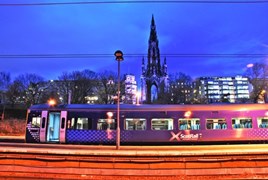It could almost be Scotland’s answer to St Pancras. The historic Edinburgh Waverley station is of critical importance to Scotland’s environmental and commercial wellbeing, as well as being key to delivering capacity for new rail lines such as the re-opening of the Airdrie-Bathgate link.
The customer base does not just comprise those who use the station for their daily commute in and out of central Edinburgh. Each day thousands of tourists and day trippers pass through the station - as well as MSPs (the Scottish Parliament building is just down the road).
Waverley’s importance has necessitated a renewal of the station. Over a four-year period a £130 million investment has transformed the station and its facilities, creating an environment that meets the needs of passengers in the 21st century while preserving Waverley’s rich heritage.
The work has included replacing the station roof, creating a new Market Street entrance, refurbishing the station concourse and main building exterior, and improving facilities for passengers. It is a remarkable investment that has effectively created a new station.
“The initial plan was to have the roof refurbished,” says Ken Brown, Balfour Beatty project manager for Waverley station. “We split our team into two, including sub-contractors from the Forth Rail Bridge project. We had to have scaffolds supporting the work we did underneath the roof.”
The team needed to understand certain limitations, such as the loadings of platforms, and small but important details such as the access requirements for Rail Gourmet staff who provide catering trolleys on trains.
It was, in Brown’s words, “a game of chess inside Waverley”, with deliveries for station retailers coming at night. With 700 train movements a day, work had to be carried out at night under possession and isolation, before the station opened for business the next day.
Suspended scaffolding was installed in the mall area, where 64,000 people pass through every day. “We could only erect that at night,” reveals Brown, while Network Rail Programme Manager Billy McKay adds: “Safety was our absolute focus. But we had to keep the live station functional.”
The station roof was the initial focus of the work, with all steelwork to be blasted and painted. “Some of it dates back to 1890,” says Brown, adding that some parts were also completely rotten and in need of replacement.
Brown explains the problems that became apparent as a result of the deteriorating structure. Drainage used to be through columns, using a siphonic drainage system with three outfalls, “so puddles used to appear throughout the station”. When engineers were refurbishing the station, they also found that “some platform drainage that was supposed to be there wasn’t”. Other challenges included broken water pipes and severed telephone wires.
Because Waverley is a listed structure (and part of a wider World Heritage Site of the Old and New Towns), Historic Scotland had very strong opinions on what could be done to the station.
The organisation, a Scottish Government agency that safeguards and promotes the country’s historic environment, insisted on certain types of detail, such as the cast balustrades. Two capitols were rotten and had to be replaced in timber by a local company. Underneath the station, elements also had to be removed. “It was difficult to get bits and pieces out of the dungeon,” says Brown.














Login to comment
Comments
Tommunbeigbe - 03/08/2015 02:36
I would like the GRANTON-BURNTISLAND line that went North from platform 19, access point in wall. There has been very little build up and the crossing should be done through a tunnel. I am shure that great tunnelling nation Norway would help. There are many alternative east west routes on this side of the Forth. but somany were lifted or downgraded on the other side.